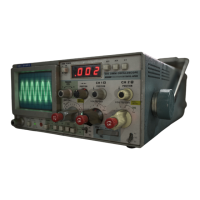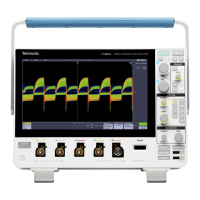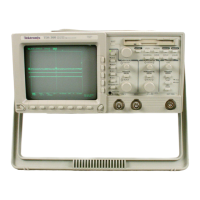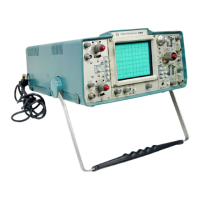Theory of Operation-314 Service
target approaches the backplate potential, yielding
higher-energy flood electrons, resulting in light output.
The storage cathode-ray tube contains special storage
elements in addition to the conventional writing-gun
elements. The operating mode of the tube depends
primarily on the voltage applied to these storage elec-
trodes. With one condition of applied potential, the
storage screen or target backplate operates in the ready-
to-write state; then, when it is bombarded with high-
energy writing-beam current, the bombarded portion
shifts to the stored mode to store a written display. With a
different set of applied voltages, the screen (target)
operates in the conventional mode, similar to a conven-
tional crt.
Flood Guns and Collimation Electrodes
Two low-energy electron guns (flood guns) are used in
the 314 crt. The cathodes are connected to -120 volts
through the Integrate switch,
S565, and R565, VR564, and
VR565. The voltage drop across VR564-VR565 sets the
voltage level of the cathode at about -90 volts. The flood
gun anode and the geometry electrode are connected
together, and the voltage levels of these electrodes are set
by adjustment R575, through (2574.
The collimation electrodes serve as an electrostatic
lens to distribute the flood gun electrons uniformly over
the storage target, and have no effect on the landing
energy of the electrons. R568 determines the voltage level
of CE, through Q570 and R573.
Target-Control Amplifier
The Target Control Amplifier is used to maintain a high
degree of control of storage backplate voltage. These
amplifiers are emitter-follower feedback amplifiers con-
sisting of Q523, Q525, and Q528. A bootstrapping circuit is
provided for each target control amplifier to maintain
transistor operating voltage during the positive-going
portion of the erase waveform (fade positive). The
bootstrapping circuits are described in full detail in the
Erase Generator description. Operating level of the
storage backplate is set by R519, Operating Level.
Erase Generator
To erase the stored display, afade-positive pulse is first
applied to the storage target backplate. This pulse in-
creases the potential difference between the flood-gun
cathodes and target backplate, raising the operating level
above the upper writing limit, writing the entire target
areas with flood-gun electrons. Next, the backplate
voltage is pulled negative, well below the retention
threshold. Then, as the backplate is gradually returned,
the target is charged to the rest potential and returned to
the ready-to-write state. The following paragraphs
describe how the erase waveform is generated.
The Erase Multivibrator is composed of
(2510, (2511,
and (2512, and associated circuitry. This is a monostable
multivibrator with Q510 quiescently saturated and Q511
biased off. The collector of Q512 is clamped slightly above
ground by the conduction of
CR513. C509 is charged to
the voltage difference between the junction of
R508-R509
and the collector level of (2512.
When the ERASE button is pushed, the contacts of
S500B are closed, grounding the junction of R501-R502.
This produces a negative-going step which turns Q510off
and Q511-Q512 on. The collector of Q512 moves down
very close to -12 volts as Q512 saturates and conducts
through R512 and Q523. The output of the feedback
amplifier steps positive, pulling the target backplate with
it. This positive step increases the operating level of the crt
and the entire target area is written.
When Q512 turns on, the negative step produced at its
collector is also coupled through C509, which turns
CR508 off, ensuring cutoff of Q510. C509 begins to
discharge .through R509, and after an RC-controlled
period, the current through R509 has diminished suf-
ficiently to permit the voltage at the anode of CR5O8 to rise
above the turn-on level. The base of Q510 is also raised to
the turn-on level and the multivibrator is switched back to
its quiescent state.
While Q512 is conducting, the charge on C513 is
removed. When Q512 turns off, its collector rises rapidly
and is clamped slightly above ground by
CR513. This
positive-going step is coupled through
C513, reverse-
biasing CR516. This positive-going step is applied to the
input of the feedback amplifier, causing the output tostep
quickly negative, well below the rest potential. As C513
charges, the voltage at the junction of R515-R516 decays
at an RC rateuntil
CR516 turnson and clamps the junction
of
R515-R516 at about -12.5 volts. This negative-going
sawtooth voltage is applied to the feedback amplifier,
which produces a positive-going sawtooth at its output to
raise the backplate to the ready-to-write state.
Bootstrapping maintains operating voltage for Q525
and Q528 during the fade-positive portion of the erase
waveform when the emitter of Q528 is pulled positive. The
voltage drop across
VR527 sets the base of Q530 ap-
proximately 51 volts below the emitter of (2528. This
voltage drop is kept constant under dynamic conditions
by the essentially constant current established by Q530
forward-bias voltage. When Q528 emitter is suddenly
stepped positive by the erase waveform, the base of
Q530
is stepped positive by the same amplitude. Q530 emitter
follows the base, and the positive-going step is coupled
REV.
A,
AUG.
1975

